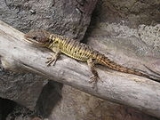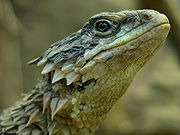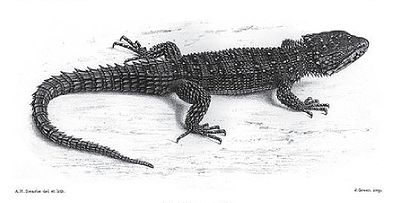
Cordylus
Encyclopedia
The genus Cordylus includes a wide variety of small to medium sized spiny lizards from Africa, collectively called girdle-tailed or girdled lizards. All are diurnal and ovoviviparous (live-bearing, with eggs). Most species are rupicolous (rock-dwelling) while a few species are arboreal or live in burrows. They defend themselves with osteoderms (flat bony plates in the skin) and by quickly retreating into rock crevices or burrows. Many species live in groups and males defend territories.
Cordylids are generally listed under CITES Appendix II. They are not necessarily threatened with extinction, but trade is controlled to prevent over-exploitation. Some species of Cordylus have limited ranges and may be threatened with habitat destruction
or over collecting for the pet trade.
(a group of legless lizards from southern and eastern Africa) and Platysaurus
. The sister group of Cordylidae is the plated lizards, Gerrhosauridae
.
Genus Cordylus

The substrate can be sand, coconut fiber, or newspaper. There should be plenty of hiding places, at least one per lizard. Rocks can be stacked into miniature cliffs or rock piles. Make sure that stacked rocks cannot fall onto captives. Provide a water bowl that is large enough for the lizard to soak when shedding its skin. A heat lamp that provides UVA and UVB for basking should be placed at one side of the enclosure. The cool end of the cage should be around 70-75o, and the area around the heat lamp should reach 90-100o. At night the cage can drop to 60-70o. Some species are found in mountainous areas where the temperature can drop below freezing.
All species are insectivorous, however some will take small quantities of fruits or vegetables, and large specimens will eat the occasional pinky or fuzzy mouse. Variety is important, try to offer different kinds of insects. Insects should not be collected from areas that have been treated for herbicides or pesticides.
Cordylus rarely reproduce in captivity, produce a small number of young (1-6), and they are slow growing, taking 2 or more years to mature. Some species, including the Sungazer (Cordylus giganteus) and the Armadillo lizard (Cordylus cataphractus) reproduce every other year or produce one baby at a time. Cordylus can live over 25 years in captivity.
The Tropical Girdled Lizard (Cordylus tropidosternum, a.k.a the Armadillo Lizard) is the most commonly available species in the pet trade. Individuals are skittish at first but most do not bite when initially captured. They will eventually become tame and will take food by hand. Other species of Cordylus may or may not become docile. Smaller species will remain skittish and large Cordylids can produce a painful, but harmless bite.
More information about caring for C. tropidosternum and other Cordylus can be found at:
www.tallbo.com
Live Birth
Sungrazers
Armadillo Lizards

Cordylids are generally listed under CITES Appendix II. They are not necessarily threatened with extinction, but trade is controlled to prevent over-exploitation. Some species of Cordylus have limited ranges and may be threatened with habitat destruction
Habitat destruction
Habitat destruction is the process in which natural habitat is rendered functionally unable to support the species present. In this process, the organisms that previously used the site are displaced or destroyed, reducing biodiversity. Habitat destruction by human activity mainly for the purpose of...
or over collecting for the pet trade.
Classification of the genus Cordylus
Broadley (2006) recognized 47 species in the genus Cordylus, including 8 species originally placed in the genus Pseudocordylus ( P. fasciatus, P. langi, P. melanotus, P. microlepidotus, P. nebulosus, P. spinosus, P. subvirdis, and P. transvaalensis) and Hemicordylus capensis. The greatest diversity of cordylids is in South Africa, with a few species found in Angola and eastern Africa as far north as Ethiopia. Other members of the Cordylidae are ChamaesauraChamaesaura
The Chamaesaura, also known as Grass Lizards, are a genus of legless lizards from southern and eastern Africa. The limbs are reduced to small spikes. The elongate shape and lack of limbs allows them to "swim" through grass...
(a group of legless lizards from southern and eastern Africa) and Platysaurus
Platysaurus
Platysaurus is a genus of lizards in the Cordylidae family, known as flat lizards for their flat backs. All species live in isolated populations in southern Africa.-Description:...
. The sister group of Cordylidae is the plated lizards, Gerrhosauridae
Gerrhosauridae
The Gerrhosauridae is a family of lizards native to Africa and Madagascar. Also known as plated lizards, they live in a range of habitats, from rocky crevices to sand dunes. Their form is variable, with some species having four fully developed limbs, and others with vestigial hind limbs only...
.
Genus Cordylus
- Angolan Girdled Lizard, Cordylus angolensis
- Dwarf Karoo Girdled Lizard, Cordylus aridus
- Barberton Girdled Lizard, Cordylus barbertonensis
- Maasai Girdled Lizard, Cordylus beraduccii
- Waterberg Girdled Lizard, Cordylus breyeri
- Campbell's Girdled Lizard, Cordylus campbelli
- False Girdled Lizard, Cordylus capensis
- Armadillo Girdled Lizard, Cordylus cataphractus
- Cloete's Girdled Lizard, Cordylus cloetei
- Blue-spotted Girdled Lizard, Cordylus coeruleopunctatus
- Cape Girdled Lizard, Cordylus cordylusCordylus cordylusCordylus cordylus , is a medium-sized lizard that is indigenous to the southern Cape of South Africa.The Cape Girdled Lizard has a golden-brown body with spiny, keeled, body scales - especially on its tail....
- Zoutpansberg Girdled Lizard, Cordylus depressus
- Eastern Cape Crag Lizard, Cordylus fasciatus
- Giant Girdled Lizard, Cordylus giganteus

- Rooiberg Girdled Lizard, Cordylus imkeae
- Limpopo Girdled Lizard, Cordylus jonesii
- Jordan's Girdled Lizard, Cordylus jordani
- Lang's Crag Lizard, Cordylus langi
- Lawrence's Girdled Lizard, Cordylus lawrenci
- Machado's Girdled Lizard, Cordylus machadoi
- Coastal Spiny-tailed Lizard, Cordylus macropholis
- McLachlan's Girdled Lizard, Cordylus mclachlani
- Mecula Girdled Lizard, Cordylus meculaeCordylus meculaeA third species from the Rhodesian Girdled Lizard complex, the Mecula Girdled Lizard Cordylus meculae, was described from Serra Mecula in northern Mozambique. It lives in granite outcrops of montane grasslands and dry Miombo woodland. The nostril pierces the center of the nasal scale and the head...
- Highveld Crag Lizard, Cordylus melanotus
- Western Cape Crag Lizard, Cordylus microlepidotus
- Dwarf Girdled Lizard, Cordylus minor
- Mozambique Girdled Lizard, Cordylus mossambicus
- Namaqua Girdled Lizard, Cordylus namaquensis
- Dwarf Crag Lizard, Cordylus nebulosus
- Black Girdled Lizard, Cordylus nigerCordylus nigerCordylus niger , is a medium-sized lizard that is restricted to Table Mountain on the Cape Peninsula...
- Cordylus nyikaeCordylus nyikaeAn isolated population of the Rhodesian Girdled Lizard from granite outcrops in montane grassland of northern Malawi was recently redescribed as Cordylus nyikae...
- Oelofsen's Girdled Lizard, Cordylus oelofseni
- Hewitt's Spiny-tailed Lizard, Cordylus peersi
- African Spiny-tailed Lizard, Cordylus polyzonus
- Herero Girdled Lizard, Cordylus pustulatus
- Rhodesian Girdled Lizard, Cordylus rhodesianus
- Cordylus rivae
- Prickly Girdled Lizard, Cordylus spinosus
- Drakensberg Crag Lizard, Cordylus subviridis
- Tasman's Girdled Lizard, Cordylus tasmani
- Northern Crag Lizard, Cordylus transvaalensis
- East African Spiny-tailed Lizard, Cordylus tropidosternum
- Ukinga Girdled Lizard, Cordylus ukingensis
- Van Dam's Girdled Lizard, Cordylus vandami
- Reichenow's Spiny-tailed Lizard, Cordylus vittifer
- Warren's Girdled Lizard, Cordylus warreni
Basic care information
The smaller species can be kept in a 10 gallon aquarium, but larger species and groups need a 40 gallon aquarium or larger. Given enough space, similar-sized species can be kept together, although they should be observed for interspecies aggression. Two males of the same species should not be introduced together. Occasionally two females of the same species will not get along and must be separated.The substrate can be sand, coconut fiber, or newspaper. There should be plenty of hiding places, at least one per lizard. Rocks can be stacked into miniature cliffs or rock piles. Make sure that stacked rocks cannot fall onto captives. Provide a water bowl that is large enough for the lizard to soak when shedding its skin. A heat lamp that provides UVA and UVB for basking should be placed at one side of the enclosure. The cool end of the cage should be around 70-75o, and the area around the heat lamp should reach 90-100o. At night the cage can drop to 60-70o. Some species are found in mountainous areas where the temperature can drop below freezing.
All species are insectivorous, however some will take small quantities of fruits or vegetables, and large specimens will eat the occasional pinky or fuzzy mouse. Variety is important, try to offer different kinds of insects. Insects should not be collected from areas that have been treated for herbicides or pesticides.
Cordylus rarely reproduce in captivity, produce a small number of young (1-6), and they are slow growing, taking 2 or more years to mature. Some species, including the Sungazer (Cordylus giganteus) and the Armadillo lizard (Cordylus cataphractus) reproduce every other year or produce one baby at a time. Cordylus can live over 25 years in captivity.
The Tropical Girdled Lizard (Cordylus tropidosternum, a.k.a the Armadillo Lizard) is the most commonly available species in the pet trade. Individuals are skittish at first but most do not bite when initially captured. They will eventually become tame and will take food by hand. Other species of Cordylus may or may not become docile. Smaller species will remain skittish and large Cordylids can produce a painful, but harmless bite.
More information about caring for C. tropidosternum and other Cordylus can be found at:
www.tallbo.com
Live Birth
Sungrazers
Armadillo Lizards


